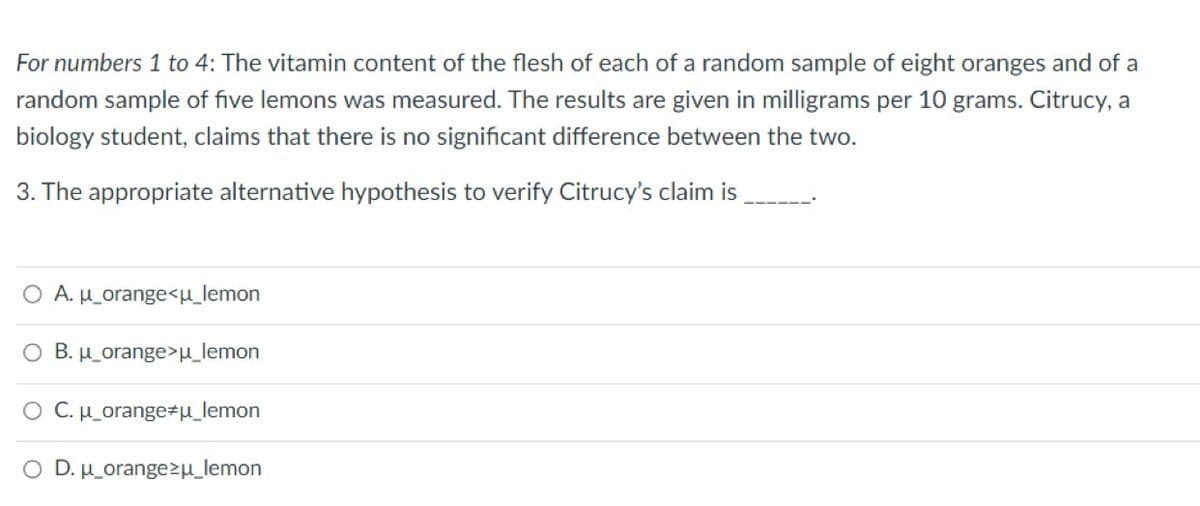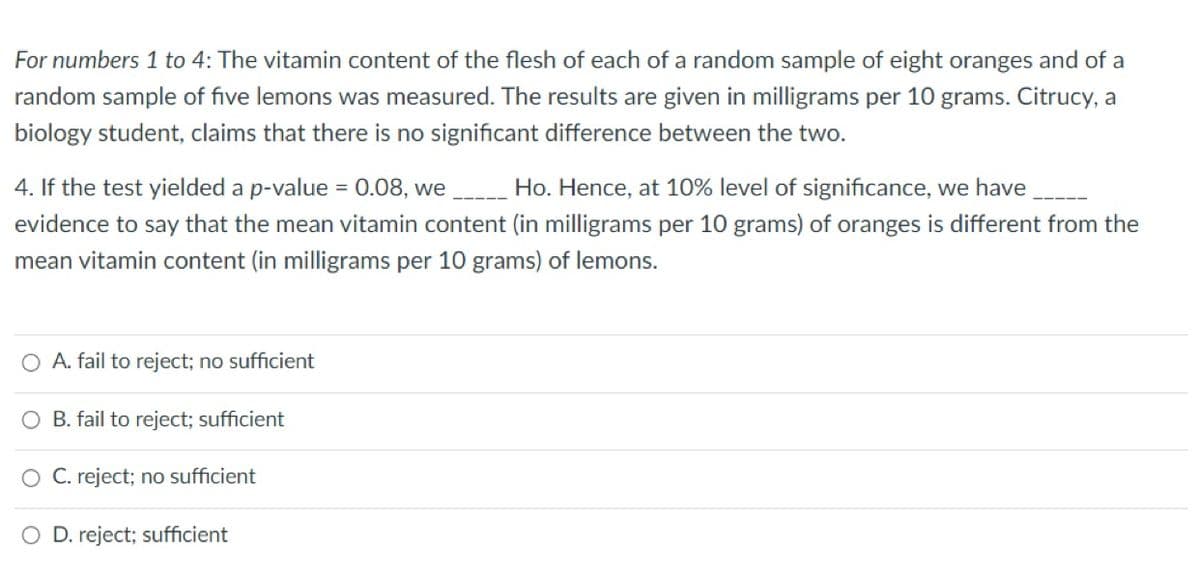For numbers 1 to 4: The vitamin content of the flesh of each of a random sample of eight oranges and of a random sample of five lemons was measured. The results are given in milligrams per 10 grams. Citrucy, a biology student, claims that there is no significant difference between the two. 3. The appropriate alternative hypothesis to verify Citrucy's claim is A. u_orangeμ_lemon O C. u_orange*μ_lemon O D. μ_orangezμ_lemon
For numbers 1 to 4: The vitamin content of the flesh of each of a random sample of eight oranges and of a random sample of five lemons was measured. The results are given in milligrams per 10 grams. Citrucy, a biology student, claims that there is no significant difference between the two. 3. The appropriate alternative hypothesis to verify Citrucy's claim is A. u_orangeμ_lemon O C. u_orange*μ_lemon O D. μ_orangezμ_lemon
Algebra & Trigonometry with Analytic Geometry
13th Edition
ISBN:9781133382119
Author:Swokowski
Publisher:Swokowski
Chapter2: Equations And Inequalities
Section2.1: Equations
Problem 76E
Related questions
Question

Transcribed Image Text:For numbers 1 to 4: The vitamin content of the flesh of each of a random sample of eight oranges and of a
random sample of five lemons was measured. The results are given in milligrams per 10 grams. Citrucy, a
biology student, claims that there is no significant difference between the two.
3. The appropriate alternative hypothesis to verify Citrucy's claim is
A. u_orange<u_lemon
O B. u_orange>μ_lemon
O C. μ_orange‡μ_lemon
O D. u_orangezu_lemon

Transcribed Image Text:For numbers 1 to 4: The vitamin content of the flesh of each of a random sample of eight oranges and of a
random sample of five lemons was measured. The results are given in milligrams per 10 grams. Citrucy, a
biology student, claims that there is no significant difference between the two.
4. If the test yielded a p-value = 0.08, we Ho. Hence, at 10% level of significance, we have
evidence to say that the mean vitamin content (in milligrams per 10 grams) of oranges is different from the
mean vitamin content (in milligrams per 10 grams) of lemons.
A. fail to reject; no sufficient
B. fail to reject; sufficient
O C. reject; no sufficient
O D. reject; sufficient
Expert Solution
This question has been solved!
Explore an expertly crafted, step-by-step solution for a thorough understanding of key concepts.
Step by step
Solved in 3 steps

Follow-up Questions
Read through expert solutions to related follow-up questions below.
Follow-up Question
Which of the following is(are) TRUE?
I. A necessary assumption for the parametric test to be valid is that the data on the vitamin content of oranges and lemons should be both
II. The parameter of interest is the difference between the
A. I only
B. II only
C. Both I and II
D. Neither II nor II
Solution
Recommended textbooks for you

Algebra & Trigonometry with Analytic Geometry
Algebra
ISBN:
9781133382119
Author:
Swokowski
Publisher:
Cengage

Algebra & Trigonometry with Analytic Geometry
Algebra
ISBN:
9781133382119
Author:
Swokowski
Publisher:
Cengage